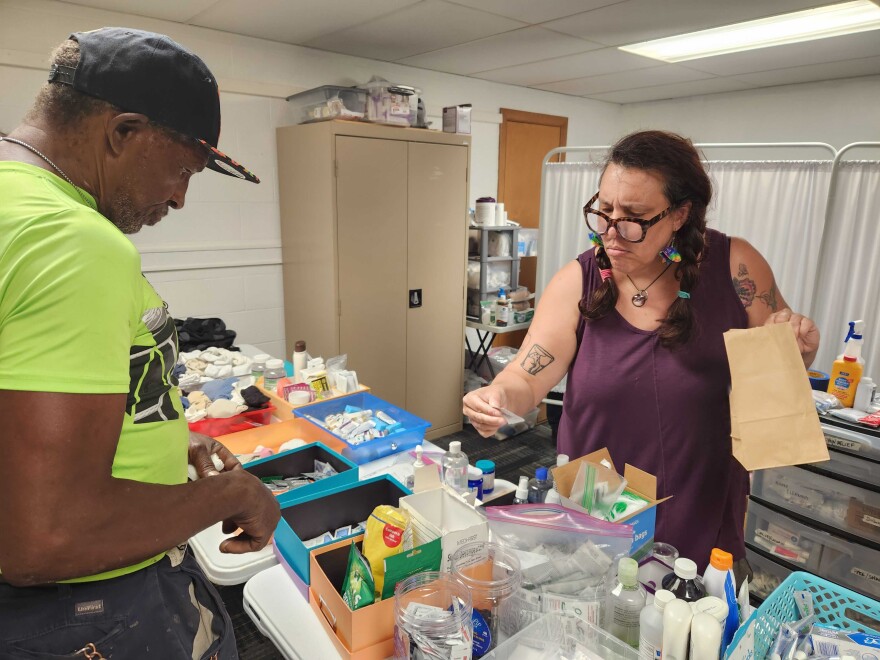Rather than relying on the uncertainty of donations, a local team providing resources and services to unhoused people will receive city funding for the next three years.
The Columbia City Council approved a new contract between COMO Mobile Aid Collective and the city Jan. 16.
The agreement is funded by the American Rescue Plan Act and gives $250,000 to COMO Mobile Aid so the group can provide food, supplies and medical aid to homeless people through 2026, according to the contract.
The contract requires COMO Mobile Aid to provide 22,273 units of service to people without housing in Columbia over three years. A “unit of service” includes a 15-minute session of contact with a person experiencing homelessness and can involve providing any kind of aid, operations manager Steph Yoakum said.
The contract lasts three years, but the collective wants to use the money sooner rather than later. Yoakum said the current budget plan projects the collective to spend the funding in the next 24 to 26 months. The contract will require the team to provide 233 hours of service a month and 58 hours a week, which Yoakum said is “easy to achieve with our services.”
“Not feeling seen or cared about and being dehumanized is a pretty big part of day-to-day life for people experiencing homelessness. This is going to enable us to be able to dedicate more time to connecting with people one-on-one as well.”Catherine Armbrust
In addition to providing food and direct medical aid, the team offers various other services: extensive medical advocacy, legal advocacy, coordination between food banks and restaurants and transportation to food stamp and doctor appointments, among others.
COMO Mobile Aid originally filed for a $500,000 grant with ARPA in 2023, but received a partial grant of $250,000. The collective has been serving Columbia’s unhoused population for far longer than the contract has existed, Yoakum said. The contract is not changing any of the services the collective provides and Yoakum said it wasn’t a big change for their team.
“The city’s a little bit behind in comparison to other municipalities in dispersing these (ARPA) dollars. But we hit the ground,” she said.
The collective was founded in 2018 as the John Brown Mobile Soup Kitchen. The team would serve 30 to 40 people one to three days a week during the winter. The collective now has a “robust” mobile soup kitchen that serves anywhere from 90 to 110 people per meal, Yoakum said. Currently, the collective serves people two days a week year-round and three times a week in the winter.
A medical clinic is housed inside the main soup kitchen and runs two nights a week for one hour each night. More than a dozen medical and nursing students, paramedics and registered nurses volunteer with the collective.
The group of medical professionals serves between 35 to 45 patients during each session in the clinic. The volunteers provide people with over-the-counter medication in 24-hour doses, first aid care, hygiene items and advanced wound care. Yoakum said the collective is lucky to be approached by these medical volunteers.
The group also hosts “Undie Mondays,” which provides undergarments to people as needed. Limited amounts of clothing, shoes and accessories are provided on “Thrift Store Thursdays.”
Mixed community reaction
COMO Mobile Aid has received a mixed reaction from the community to their mission and services, Yoakum said.
“The outpouring support for people seeing acts of radical hospitality or unconditional giving has been wonderful. We’ve received a lot of support,” she said.
Other residents are less than thrilled about the services, instead considering the collective and their aid to be “enablers,” Yoakum said.
“A lot of people behave a little bit like daytime sadists,” she said. ”And there are people who just kind of enjoy or take some sort of pleasure in pointing out all of this suffering and imply that alleviating any of that suffering is a moral failure on our part and that it is wrong.”
The collective has received hate calls and faced harassment frequently, said COMO Mobile Aid Director Catherine Armbrust.
“We are growing because homelessness is growing,” Armbrust said. “Homelessness is not growing because we are growing.”
Yoakum hopes this contract is just the beginning of being able to provide “more robust, more cost-efficient (and) more effective services” geared toward people experiencing homelessness and those with extreme mental illnesses or intellectual and physical disabilities.
“Not feeling seen or cared about and being dehumanized is a pretty big part of day-to-day life for people experiencing homelessness,” Armbrust said. ”This is going to enable us to be able to dedicate more time to connecting with people one-on-one as well.”





